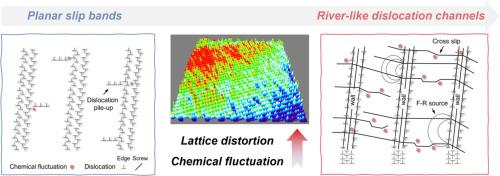River-like dislocation channel unleashes high tensile ductility in as-cast refractory multi-principal element alloys
IF 12.8
1区 材料科学
Q1 ENGINEERING, MECHANICAL
引用次数: 0
Abstract
Dislocations govern the plastic deformability of structural alloys. However, this beneficial role is compromised in refractory multi-principal element alloys (RMPEAs), where tensile ductility degrades owing to plastic strain localization via planar slip and dislocation channeling. We proposed a ductilization concept based on engineered dislocation channels to divert and dredge dislocations, achieving a notable tensile ductility of 21% and a yield strength exceeding the gigapascal mark in the as-cast RMPEA. To test the hypothesis that enhanced lattice distortion and chemical fluctuations act as dislocation diverters, we designed Ti53V15Hf32 (V15) and Ti41V27Hf32 (V27) RMPEAs with distinct volume misfit and Warren-Cowley parameters. In-situ synchrotron high-energy X-ray diffraction and transmission electron microscopy analyses revealed that increasing the volume misfit facilitates a transition in dislocation character from edge-based (V15) to screw-based (V27) under tensile loading. Atom probe tomography and high-angle annular dark-field scanning transmission electron microscopy characterizations further demonstrated that elevated V content engenders pronounced chemical fluctuations, inducing diversion of dislocation slip and the formation of river-like dislocation channels. These dislocation channels, on one hand, promoted dynamic strain hardening through dense intersections of the channel boundaries. On the other hand, they prevented premature necking and failure by enabling dislocations to proliferate and cross-slip within channels. Consequently, the river-like dislocation channels delayed plastic instability at ultrahigh yield strength, thereby enabling the RMPEA to unleash exceptional tensile ductility. These findings provide a dislocation-harnessing pathway for pursuing strength-ductility synergy in RMPEAs.

河流状位错通道释放出铸态耐火多主元素合金的高拉伸延展性
位错控制着结构合金的塑性变形能力。然而,这种有益的作用在难熔多主元素合金(rmpea)中受到损害,其中由于平面滑移和位错通道引起的塑性应变局部化而导致拉伸延展性下降。我们提出了一种基于工程位错通道的延展性概念,以转移和疏通位错,在铸态RMPEA中获得了21%的显著拉伸延展性和超过千兆帕的屈服强度。为了验证增强的晶格畸变和化学波动作为位错转移剂的假设,我们设计了具有不同体积失配和Warren-Cowley参数的Ti53V15Hf32 (V15)和Ti41V27Hf32 (V27) RMPEAs。原位同步加速器高能x射线衍射和透射电镜分析表明,在拉伸载荷下,体积错配的增加促进了位错特征从边缘型(V15)向螺旋型(V27)的转变。原子探针层析成像和高角度环形暗场扫描透射电镜表征进一步表明,V含量的升高引起了明显的化学波动,导致位错滑移的转移和河流状位错通道的形成。这些位错通道一方面通过通道边界的密集相交促进了动态应变硬化。另一方面,它们通过使位错在通道内增殖和交叉滑移来防止过早的颈缩和失效。因此,河状位错通道延迟了超高屈服强度下的塑性不稳定性,从而使RMPEA释放出优异的拉伸延展性。这些发现为rmpea中追求强度-延性协同提供了脱位控制途径。
本文章由计算机程序翻译,如有差异,请以英文原文为准。
求助全文
约1分钟内获得全文
求助全文
来源期刊

International Journal of Plasticity
工程技术-材料科学:综合
CiteScore
15.30
自引率
26.50%
发文量
256
审稿时长
46 days
期刊介绍:
International Journal of Plasticity aims to present original research encompassing all facets of plastic deformation, damage, and fracture behavior in both isotropic and anisotropic solids. This includes exploring the thermodynamics of plasticity and fracture, continuum theory, and macroscopic as well as microscopic phenomena.
Topics of interest span the plastic behavior of single crystals and polycrystalline metals, ceramics, rocks, soils, composites, nanocrystalline and microelectronics materials, shape memory alloys, ferroelectric ceramics, thin films, and polymers. Additionally, the journal covers plasticity aspects of failure and fracture mechanics. Contributions involving significant experimental, numerical, or theoretical advancements that enhance the understanding of the plastic behavior of solids are particularly valued. Papers addressing the modeling of finite nonlinear elastic deformation, bearing similarities to the modeling of plastic deformation, are also welcomed.
 求助内容:
求助内容: 应助结果提醒方式:
应助结果提醒方式:


